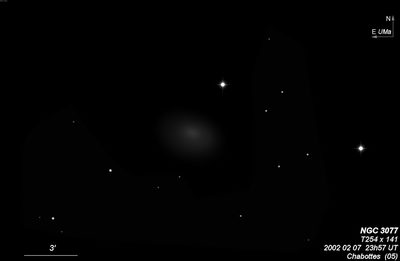
William Herschel discovered NGC 3077 = H I-286 = h658 on 8 Nov 1801 (sweep 1100) and remarked "vB, cL, R, vgmbM. On the north-following side there is a faint ray interrupting the roundness." Caroline's reduced position is 8' too far south. Wilhelm Struve independently found the galaxy in 1825 or 1826 and included in his list of 9 "Nebulae dectae" in an appendix to his main catalogue of double stars (∑ 3). John Herschel's position, measured on 28 Oct 1831 (sweep 377) was accurate in declination, but 1 min of RA too far west. Ralph Copeland, observing with LdR's 72" on 26 Dec 1873, noted "vB, L, R, comet like with 2 streams of neby towards the south."
400/500mm - 17.5" (3/23/85): fairly bright, fairly large outer halo elongated SW-NE, increases to brighter core. Mag 7.9 SAO 15054 (∑1400 = 8.0/9.8 at 3.4") lies off the NW side 3.8' from the center. Located 45' ESE of M81 (member of the M81 group).
600/800mm - 24" (4/20/14): at 260x appeared very bright, very large, oval 4:3 SW-NE, large bright core, gradually increases to a small brighter inner core and occasionally a faint stellar nucleus. The outer halo seems brighter or more extensive on the north-following side and gradually fades, so the periphery has a very low surface brightness. Two similar unequal doubles are in the field: ∑1400 = 8.0/9.8 at 3.4" lies 3.8' NW and ∑1398 = 8.1/11.4 at 3.6" lies 10".
Notes by Steve Gottlieb